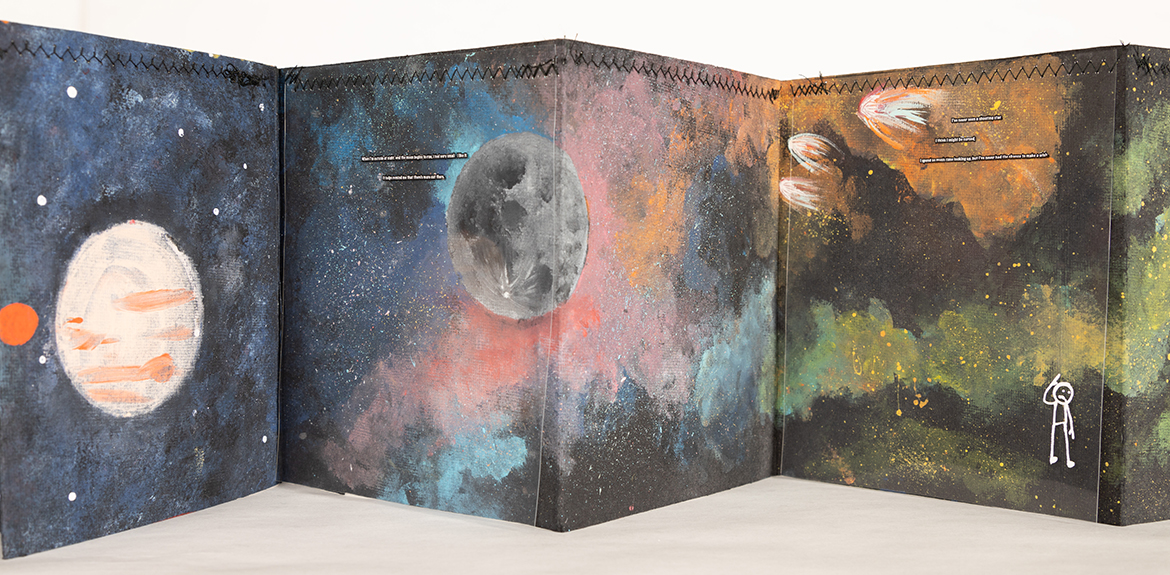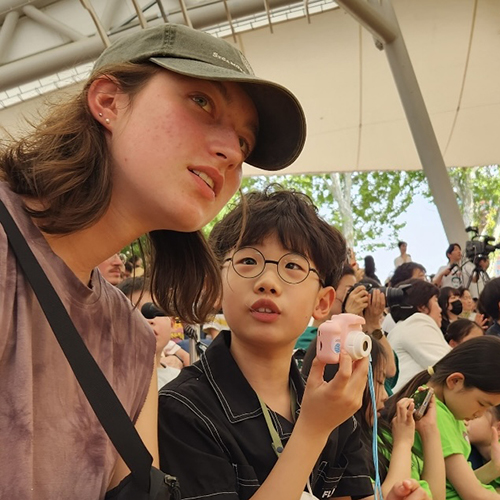On a high shelf in the UW Art Building, there’s a hamburger bun with a story to tell. The bun, crocheted in yarn, serves as the front and back cover of a book created by a team of art and creative writing students. Sandwiched within the bun halves is an illustrated story set in a fast food restaurant.

The book is one of nine final projects created by students in a book arts course offered by the Department of English and the School of Art + Art History + Design (SoA+AH+D).
“I really wanted to see what a collaborative experience like this would be like for my students,” says Maya Sonenberg, professor of English, who co-taught the course with Claire Cowie, SoA+AH+D interdisciplinary visual arts lecturer. “I think writers are particularly self-contained. They usually do their work in a room alone, or wearing headphones to block out others. I was interested in collaboration as a process, recognizing how necessary it is in one’s life, both personally and professionally.”

Sonenberg had focused on book arts in previous courses, and had taken her students to Suzzallo Library to view hundreds of artist books collected by Sandra Kroupa, book arts and rare books curator for University Libraries Special Collections. Kroupa was aware of Cowie’s interest in artist books as well, and encouraged the two faculty members to meet.
Cowie and Sonenberg first tried a mini-collaboration in which their art and creative writing students traded their work back and forth, revising along the way. The success of that experiment led to the spring quarter class. Though Cowie and Sonenberg officially offered separate courses, in reality the two classes met together, with all 36 students collaborating in interdisciplinary groups on several projects. “We were surprised at how well all the groups worked,” says Cowie. “We tried to pair students with people they wouldn’t normally work with, but who we thought they’d be compatible with. It was a delicate balancing act.”

Artist books are a delicate balancing act as well, imparting equal importance to words and images. The tradition dates back to the middle ages, when illuminated manuscripts included imagery that went beyond the content of the text. In the late 1700s and early 1800s, artist and writer William Blake further explored the integration of art and text. But the popularity of artist books exploded in the mid-twentieth century, with a greater focus on sculptural books that emphasized form and materials. Bound books, books with accordion folds, books created from bed parts — everything was fair game.

For their final book project, Sonenberg and Cowie had their students create accordion books, so-named because they fold in a simple zigzag pattern and open wide like an accordion. The format is easy to build and offers intriguing options for storytelling. Pages can be read individually or as a wide panorama, and the two-sided structure lends itself to explorations of duality. The hamburger-bun book, for example, explores one scene from two perspectives — a fast food worker’s view on one side, a customer’s on the other. Another book captures a couple’s relationship, with dialog from the couple’s first meeting on one side and their break-up on the other. The couple’s internal thoughts are jotted on notes tucked under the text.
Emily Sawan, an English and psychology major, was on a team that created I Am the Universe Observing Itself, a book that captures the different ways people think about outer space. One side of the book is whimsical, the other scientific. “We also wanted to have an element of audience interactivity,” says Sawan, “so we shrunk the text and included a telescope magnifying glass in an attempt to have our readers engage with the book, thereby making our title come true. “

In a previous course with Sonenberg, Sawan completed a book-making project and was frustrated by her own artistic limitations. She saw the opportunity to partner with art students this time around as a huge plus. “The aspect of collaboration was simultaneously the hardest and most exciting portion of the class,” Sawan says. “Most surprising was how well all of our ideas fit in, and how willing to work together we all were.”
Class visits to Special Collections helped to spark all the students’ imaginations. “Some of those books were jaw dropping and absolutely blew my mind,” says Justin Williams, a major in interdisciplinary visual arts. “The amount of creativity just opened my mind to the possibilities that could be created in making a book.”
Cowie and Sonenberg hope their students continue to visit Special Collections on their own and continue to appreciate the value of collaboration across disciplines. Co-teaching this course, they’ve had their eyes opened as well.
“This class has changed my preconceived notions and expectations for what my students can do,” says Cowie. “They have capabilities and interests I wouldn’t have seen without this class. And teaching with Maya, I’ve been excited and grateful for that different perspective. I’m totally taking some of her ideas and using them in the rest of my classes.”
. . .
Check out our Flickr gallery for more photos of completed artist books from the class.
More Stories

Democracy by the Numbers
Mathematics and Democracy, an undergraduate mathematics course, explores the role of math in many aspects of democracy, from elections to proportional representation.

A Statistician Weighs in on AI
Statistics professor Zaid Harchaoui, working at the intersection of statistics and computing, explores what AI models do well, where they fall short, and why.

Finding Family in Korea Through Language & Plants
Through her love of languages and plants — and some serendipity — UW junior Katie Ruesink connected with a Korean family while studying in Seoul.